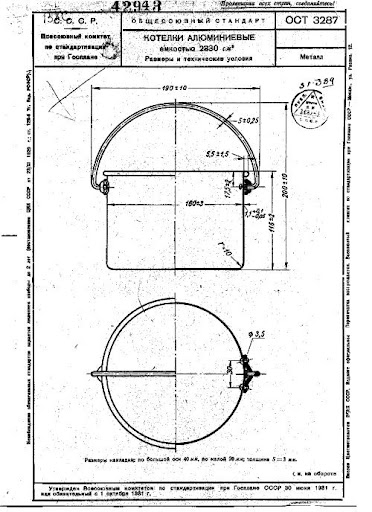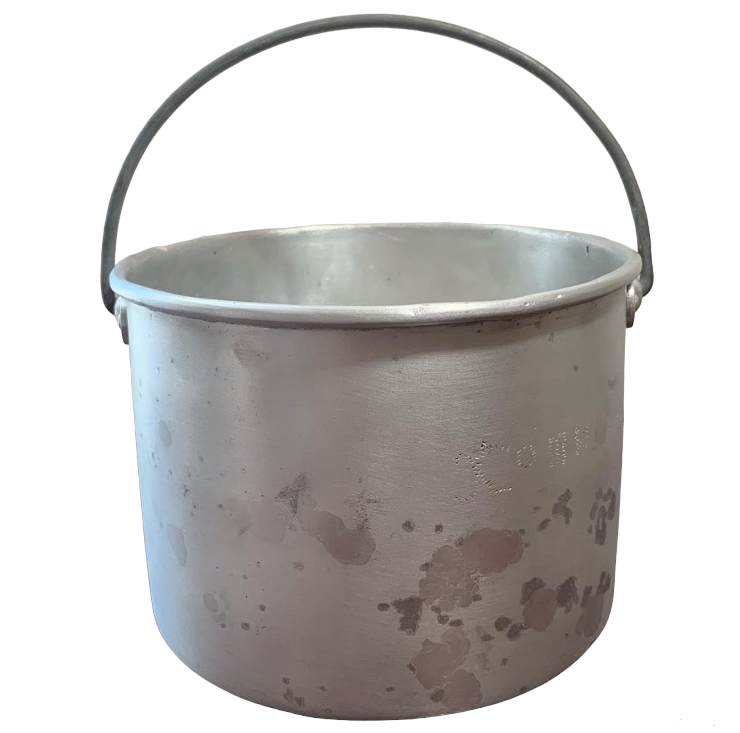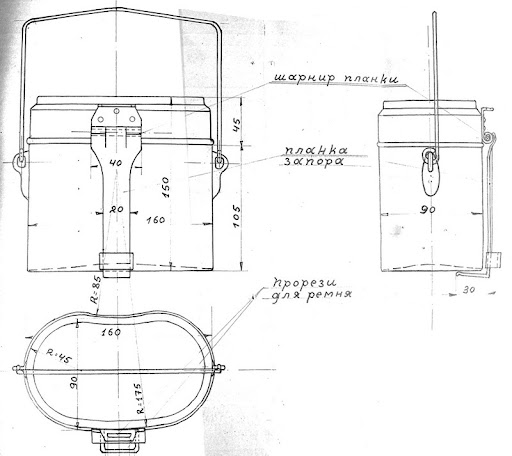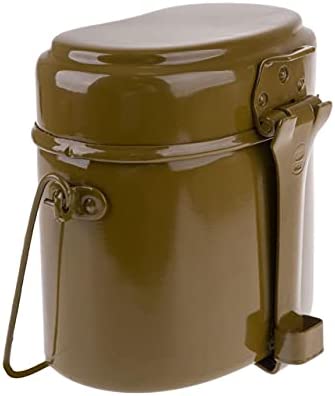Soviet Mess Kit Primer
The Red Army used several models of mess kit from 1927-1945. The use of these kits was dictated mainly by access to raw materials: in the prewar period, use of aluminum in models of mess kit was almost universal. However, when the stresses of increased mobilization in the late 1930s, and of course the beginning of the Soviet Union’s battle for survival in 1941, cheaper alternatives were sought. By the end of this trial, models made from tinned steel were ubiquitous, saving millions of tonnes of aluminum for aircraft production.
This document is a quick introduction to the main models, their usage, and any technical information we can provide. As a resource for reenactors, we will also judge the appropriateness of use for these models for different time periods, and compare them to cheaper alternatives for use in the field.
Obr. 1927 Mess Pot
Before 1927, there does not seem to be any standard model of mess kit in use. Instead, we see a myriad of leftover Tsarist items in use, along with what appear to be civilian items pressed into service. This should not be surprising; the Red Army of the 1920s was recovering from WWI and the Civil War, and other than border skirmishes in Central Asia, China, and in Poland, there was no major action.
Starting in 1927, we begin to see round, aluminum pots being produced at the Red Vyborger aluminum plant in Leningrad. These pots were large, 3 litre capacity, and carried at the bottom of the greatcoat roll (skatka). They seem to have been unpainted, but we cannot find a prikaz either way.
These kits can be seen all through the 1930s, and into 1941. There are some photos of shiny pots in use through 1941-45, but without corroborating evidence, we cannot be sure if these are aluminum or unpainted steel. According to Russian collectors, this model of pot was discontinued in 1936, although a large reserve of pots had been built up for future use.
There may have been reproductions of this model made. I have acquired two of these, and they are very close to original examples. I unfortunately can not see any record of who made them, where they came from, or when they were sold. Unfortunately, if you want to use one of these, originals are your only option.
They are somewhat impractical, only useful for eating one thing at a time. If you hate having your food touch, this model (and its steel brother) will not be to your liking. They also lack a cover, limiting their ability to transport food long distances or to keep flies off your stew. A veteran remembered this:
“They gave me a bowler hat, and in it – pasta with stew. Artillery and mortar shelling began, I covered the bowler hat with my body so that clods of earth would not get into the food” – Efim Abelevich Golbreykh, Artilleryman.
Below is a photo of the Obr. 27 in use, circa late 1920’s.
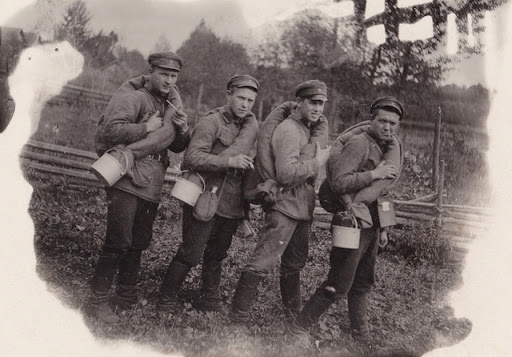
Obr. 1936 Mess Kit
Beginning in 1936, a mess kit influenced by the German M.31, as well as the kidney shape of some Tsarist models, was produced at the Red Vyborger plant in Leningrad. This was a two piece model, with an all aluminum construction, even the bale. It is differentiated from the German M.31 by its three rivets holding on the handle on the lid, and its lack of fill lines. It had a capacity of 1.7 litres in the bottom, and .5 litres in the top. They were issued widely in the prewar period, carried on the back of the tornister, or later on in the meshok.
A key detail of the Obr.36 is the bale attachment lug on the side. There were three main variations. The “long ear” seems to be standard, attached with a hidden rivet. There was also a “short ear” model, which resembles the postwar square lug, but is rounded off. Finally, there were long eared models that were attached by exposed rivet.
These are fantastic to use, as the two part construction is conducive to eating more than one type of food at once, and the lid allows protection from spillage.
Around 1940, the order was given to paint the bright aluminum kits in a “protective” green to camouflage them. We cannot say how extensively this order was applied.
Originals are not expensive, but can be in rough condition. In addition to using an original, there are postwar examples of the Obr36 that range from just acceptable to carbon copies. These are detailed below.
Original prewar Obr. 36 on top, early postwar messkits on the bottom made at Apkaustas/ Pirmunas.
Steel Pots
In 1941, we begin to see the shift away from the use of aluminum in soldier’s equipment. The reason is twofold: to save aluminum for aircraft production, and because of the Siege of Leningrad. In the fall of 1941, the second capital of the Soviet Union found itself under siege, and the Red Vyborger aluminum plant, the most modern and productive plant in the Soviet Union, was cut off by German and Finnish forces. The plant still operated, but apparently did not make aluminum cookware, as no mess kit or canteen with wartime dates (other than 1941) have yet been found.
To fill this massive gap in a soldier’s equipment, steel alternatives were created. At first, enameled steel pots emerged, in the same shape as the Obr.27. However, these were quickly supplanted by the much more durable tinned steel pot. The Lysvensky Metallurgical Plant (LMZ) perfected a process that only tinned the inside of the pot, allowing significant savings of tin and speeding manufacturing time. In all, LMZ produced an estimated 14-20 million steel pots between July 1941-1945. This is in addition to artisan level production of different models, which could range from a perfect Obr.27 copy to items that look more at home in a kitchen than the battlefield. . As far as we can tell, the steel copy of the Obr.27 did not have a model designation.
As such, the steel pot would have been predominant in RKKA use during the war years. Of course, we see both pots and kits in use, but we recommend a steel pot.
Originals, being prone to rust, are rare to find, and are usually in poor condition to be used. Reproductions of the enameled steel model are being made in the Czech Republic, and in the early 1950s, the Soviet Army produced one more run of steel pots for unknown reasons. These usually have 1950-1953 dates, and are carbon copies of LMZ types. We highly recommend these for use.
Postwar Examples
Obr.1948
After the war, the Red Army decided to move back to aluminum. In 1948, a new model of kidney kit was produced, and was in production until the end of the Soviet Union. It is largely the same as the Obr.1936, with the exception of square bale attachments, as compared to the “long” bale attachments. From 1948-1956ish, they were painted a “protective” green colour similar to wartime paint. In 1956, they were painted in the familiar puke green. Obr.48s are acceptable for use, as long as they are stripped, or in the 1948 color.
Below is an example of an Obr. 48 mess kit with the improper 1956 paint and square lungs, these may only be used with the paint stripped.
Reparation Kits
In order to pay for their crimes, the new East German state was ordered to produce material for the occupying Red Army. We see uniforms, pouches, and boots made, in addition to aluminum goods, like canteens and mess kits. These mess kits are almost carbon copies of the Obr36, and should be sought after for reenacting use.
Apkaustas/ Pirmunas Kit
From 1950-1954, the Apkaustas plant in Soviet Lithuania produced a model of mess kit that was another close copy of the Obr36, with slight differences. These kits have the “long” bale lug, with two exposed rivets holding it in place. These ears can be very rough, but are closer to the Obr36 than the Obr.48. After 1954, the Pirmunas Plant switched to making the normal Obr.48 kit. (See photos above.)
Sources:
https://iremember.ru/memoirs/pekhotintsi/golbraykh-efim-abelevich/
https://warspot.ru/3523-frontovaya-zhest

